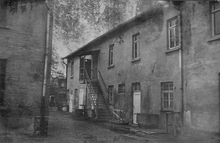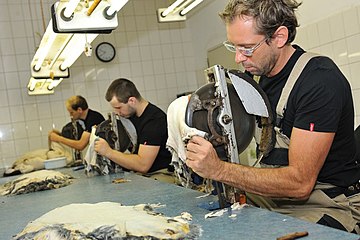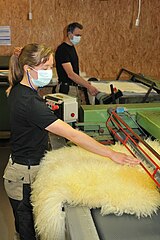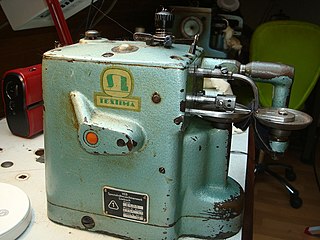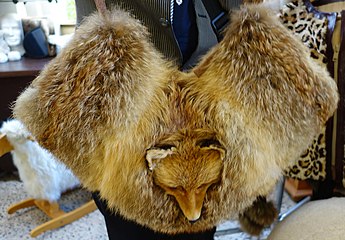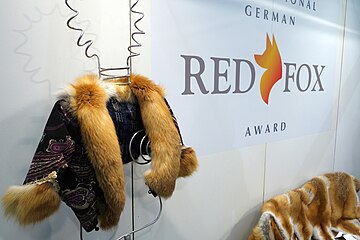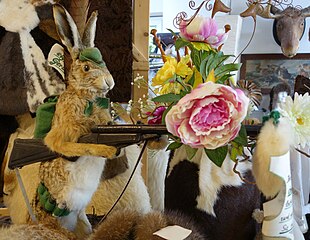Udo Meinelt & Sons
| Udo Meinelt & Sons
|
|
|---|---|
| legal form | GbR |
| founding | October 17, 1931 |
| Seat | Rötha |
| management | Bertram Meinelt |
| Number of employees | approx. 17 (2019) |
| Branch | Smoking goods dressing, fur refinement, skinning, fur cleaning, preparation |
| Website | http://pelz-meinelt.de/ |
The company Udo Meinelt & Söhne in Rötha comprises the main parts of the business : the finishing of tobacco products , the skinning , the fur cleaning and the preparation . The company was one of the few private fur trimmers in the GDR. It is the only one that still exists in the vicinity of the former World Fur Center in Leipziger Brühl .
The third generation of master furriers and smokers work for private individuals, hunters, taxidermists, sheep farms, zoological gardens and museums. In 2007 it was said that Udo Meinelt's furrier business was the only one in Germany that processes the entire product, from raw fur to fur jackets.
General
Until the Second World War, the Leipziger Brühl had the reputation of being the “world street of furs”. It was the most important street in the city. For some time, the tobacco industry companies located there generated the largest share of Leipzig's tax revenue. In addition, manufacturing businesses in the fur industry had settled around Leipzig, above all tobacco shops , the fur- tanning businesses. At the beginning of the 20th century there were almost 50 fur trimmers in the vicinity of Leipzig. In Rötha alone there were around 35 furriers and dressing companies.
When the National Socialists came to power in 1933, the Brühl lost part of its international reputation. Unlike the fur trimmers, the fur wholesalers had predominantly Jewish owners who either had to give up their businesses or relocated abroad, where they committed themselves to boycott Germany. Most of the international business connections with them were lost, and the Second World War (1939–1945) brought another downturn, with the exception of the Wehrmacht orders. After the end of the war, most of the company owners left the Soviet-occupied part of Germany because they no longer saw a future for themselves in the socialist GDR with their company expropriations. In Frankfurt am Main, the fur trade center Niddastraße formed a new fur trade focus for a few decades , comparable to Brühl in terms of its world significance.
The fur dressing and dyeing factories could not actually be relocated due to their operational structure. Some large companies were also newly founded in the Federal Republic; for fur trimming, however, no center was formed, even remotely comparable to Leipzig. Insofar as the original fur trading operations in the GDR were not given up, they were transferred to state or semi-state operating forms together with most of the other fur processing plants.
Essentially, the goods were allocated for the fur processing companies in the GDR via the Leipzig-based Cooperative of the Kürschner-Handwerk e. G. mb H. In August 1977 Udo Meinelt was registered there as a comrade with a share of 100 marks, in 1980 seven shares were added, each with the same amount.
A circular from the cooperative to the Meinelt company, "Preparing the elections for the People's Chamber and the District Convention " in 1981 , indicates the relationship between the state and privately run companies in the GDR:
- “The Chamber of Crafts refers us to the groundbreaking resolutions passed by the Xth Party Congress of the SED for the coming years.
- The representatives of the people have a high degree of responsibility for the rapid implementation of these resolutions. The election of the People's Chamber and the District Days on June 14, 1981, will therefore be a first essential step towards realizing the resolutions of the Xth Party Congress of the SED and further strengthening socialist democracy.
- In addition to the discussions to be held about the election call of the National Council of the NF of the GDR a . The visual advertising must also be ensured through the informative design of the shop windows or showcases. [...]
- We expect that you will document the alliance between the craft and the working class through appropriate activities and good visual advertising. "
Udo Meinelt
The parents' family moved from Dresden , the birthplace of Udo Meinelt (* 1940), to Berbersdorf near Döbeln in 1945 and to Leipzig in 1949. In 1931 Udo's stepfather, Helmut Höfgen (June 14, 1912; † 1972), founded a furrier workshop in Leipzig-Lindenau, Rietschelstrasse 6. Helmut Höfgen passed his master craftsman examination on June 6, 1940 at the Leipzig Chamber of Crafts .
After his apprenticeship as a furrier, Udo Meinelt gained further experience in his stepfather's business, in the Leipzig furrier workshops of the Walter Wylezich company and the G. Nauck fur house . In 1967 Udo Meinelt passed his master craftsman examination as a furrier in Leipzig. The trade policy of the GDR did not allow him to continue running his parents' business after the death of his father in 1972, despite having passed the master craftsman's examination. So until 1977 he worked as a furrier at the Rudolf Nagel company . In October 1977 he opened his own fur shop with his wife Beate at Georg-Schwarz-Straße 176, at the corner of Pfingstweide, and temporarily operated under his private address Oststraße 2.
At the same time as the medal of honor for the 40th anniversary of the German Democratic Republic , Udo Meinelt received the medal “ Activist of Socialist Work ” on October 7, 1989 .
After the end of the GDR, the Leipzig furrier guild was re-established on March 23, 1990 and Udo Meinelt was appointed head master, one of the first four freely elected head masters in the GDR - a post that he gave up in the same year.
Company history
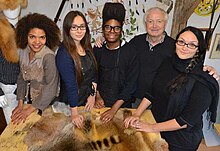
There were state-set prices for handicrafts in the GDR. The Leipzig City Council, Price Department, was responsible for the Leipzig area. A special feature was that Udo Meinelt was classified as a private company in price class 1, for "companies whose products represent particularly high performance in terms of cut, shape and processing". According to the "Price Ordinance No. 315 on Price Formation in the Furrier Trade", he was thus allowed to demand higher prices for services.
Before the fall of the Berlin Wall, Udo Meinelt was busy expanding his furrier business to include fur cleaning and fur trimming, in particular sheepskin trimming. In 1989 he tried to take over the former, once very important tobacco dye works Alfred Essigke , Holbeinstraße 38, later owner Horst Köhler, from the responsible authorities and at a higher level . Koehler sen. was the last manager of the property of the now closed company. In a joint letter from the SBBM (City District Mayor) for Planning and the City District Council for Local Cooperation to the City Commission of the City of Leipzig on June 26, 1989 it said:
- “We have been informed that the property must be made public property in order to be able to be preserved. We hereby apply to grant Meinelt the premises of the former Köhler company. The great professional interest of Mr. Meinelt and his tireless dedication give the guarantee that in a short time a remarkable and efficient service offer will be created ”.
In November 1989 Udo Meinelt received from the city the temporary assignment of the commercial space in Holbeinstrasse, ground floor and 1st floor, under the condition that the current state of the facilities was secured. The landlord was now Erika Bernhard , Leipzig. It had previously been agreed in front of the Chamber of Crafts that the property would be used for fur cleaning and fur trimming. The Meinelt company was to create exhibition and teaching rooms for the furrier trade on the third floor. The possibility of transferring the property into public ownership should be examined, a building report drawn up at the same time and the preservation authorities informed. In the long term, the VEB Fleece Textiles located on the 2nd floor should be outsourced in order to use the floor for exhibition purposes of the Chamber of Crafts for the furrier trade. However, it turned out that the building was too dilapidated, and after a few days the building supervision closed the building, which meant that the project had failed.
In April 1990, Udo Meinelt instead bought the entire inventory in the rear building at Gemeindeamtsstrasse 7/9 from Leipzig's master smokers' finisher Harry Bader and took over his contracts, including the rental agreement. In 1991 the Meinelt company moved from the Leipziger Gemeindeamtsstraße to the current premises in Rötha, Heinestraße 30. The long-established tobacco dye factory Karl Thieme had its factory here until after the Second World War, but at that time the buildings were only used as storage rooms by an electrical company.
Wesley Petermann (born March 23, 1994 in Sorocaba, Brazil) stood out among the company's numerous apprentices. After attending a design school and training as a furrier, he became known for his eye-catching fur designs and his media presence.
Up to the present day, the senior boss Udo Meinelt has managed to get positive press for his company, despite the fur industry, which has been criticized in recent decades. At a time when the furrier trade in Germany was losing its businesses dramatically and there was unemployment in parts of the former GDR, he repeatedly referred to his full order books and also complained about the lack of suitable workers, or, as one headline said, he was looking for “employees desperately”. In 2003, according to his information, the order lead time for finishing orders was six months, and correspondingly longer for subsequent further processing. According to Udo Meinelt, the order books were full for one year in 2017, the number of customers was between 5000 and 7000, 15 percent of whom came from abroad.
The son Tobias Meinelt (* 1979), who was also practically active in the business as a co-owner, died in September 2018. The management of the company is now with his brother, furrier and trained tobacco maker, Bertram Meinelt, who also works in the business.
Fur dressing, fur refining and leather tanning
In the field of fur finishing , the company also covers the entire spectrum, from tanning a mouse skin , to mass-produced lambskin or fox skin , to giraffe skins , rhinoceros and elephant skins .
In 2006, the company received funding from the Federal Ministry of Economics and Technology as part of the “Funding of research, development and innovation” for a “process for manufacturing hides of all kinds by tanning with tanning aids obtained from natural raw materials” developed by Udo Meinelt & Sons in small and medium-sized enterprises and external industrial research institutions in the new federal states ”.
| The company's price list for fur tanning from September 2012 listed the following frequently occurring animal species: |
|||
|---|---|---|---|
| Red fox | Raccoon dog | Mouflon | Rabbits , angora rabbits |
| marten | Nutria | deer | Calf , galloway , cattle (skin) |
| Polecat | Muskrat | Wild hare | bison |
| Badger | deer | sheep | Goat , kid |
| racoon | Fallow deer | wild boar | |
When Germany's largest grizzly bear "Taps" died in 2002, it was prepared in the Udo Meinelt company before it was worked out by the taxidermist there to become a "showcase preparation" for the Chemnitz Natural History Museum. As junior Tobias Meinelt told the press, this was an unusual job even for him, even if the rhinoceros fur at the Leipzig zoo weighed 250 kilograms last year. The bear fur weighed 120 kilograms when it was delivered: “The 20 centimeter thick layer of fat had to be removed by buckets”. The purpose board required for stretching was 2.50 by 3 meters. The upright prepared bear has a total height of 2.90 meters.
Fur cleaning
A specialty of skinning is fur cleaning . In 1988, towards the end of the GDR, the Brühlpelz and Leipziger Pelzmode companies rejected the cleaning of furs, which they said they did not deal with. Instead, both referred the customers to Meinelt. Another fur-cleaning company was “not known at the moment” in the state-owned Brühlpelz enterprise; PGH Leipziger Pelzmode knew that master furrier Udo Meinelt “carries out manual cleaning with good success”. In the same year Udo Meinelt applied that he could charge a higher price for heavily soiled items of fur clothing that had to be cleaned manually several times. In a transcript of the minutes of a related discussion at the Chamber of Crafts, it also said: "The Meinelt company has been performing this activity with great success in excellent quality for about 2 years".
In a memo from March 1988 it is mentioned that for the colleague Udo Meinelt, who is the only master furrier in the district who carries out the professional cleaning of fur clothing, “it was unanimously decided to do everything possible to maintain this achievement for the population. The "representatives of the professional group management were" impressed by the initiatives of Koll. Meinelt, who developed some of the machines and devices necessary for cleaning himself in order to revitalize the value retention and revaluation of fur clothing for our population [...] "During a company inspection the colleagues had found significant, unpaid services. In 1988 the cleaning prices were between 4.50 and 13.40 marks. The list shows some of the secondary activities involved in cleaning fur:
- Provision of the chips and ingredients, with all associated transport routes, calculated too tightly
- Disposal of the bins with removal of the chips, after an object approx. 10 km away, the volume of the chips has increased significantly due to dust, hair, etc.
- The cleaning of the lauter tun and shaking bins is much more time-consuming than originally estimated.
- The inspection of the items of clothing handed over by the citizens (buttons, buckles, hair and leather damage) must be carried out more intensively
- The special treatment was not calculated, based on experience, bleached and dyed material that has been bleached and dyed several times , which has to be temporarily stored and processed separately [additional expenses]
- Remove and note the dimensions of each item of clothing due to a possible later complaint (knowledge from 2 legal disputes with citizens)
- For necessary repeated cleaning of heavily soiled or old pieces that have already been cleaned several times, an additional cost of approx. 50% must be expected.
In order to try out fur refinements that are as chemical-free as possible, especially for allergy sufferers or as a baby pad, Udo Meinelt experimented in 2003 with, among other things , tanning agents obtained from rhubarb . The research institute for leather and synthetic sheeting at the Technical University of Freiberg has confirmed the successful tanning process. As early as 1990 a customer letter said: We “clean all furs organically, whether fox, hare, deer, wild boar, rabbit, nutria, marten, etc. a ".
Dressing room
When the company was still on Georg-Schwarz-Straße, they had a small museum there, a fully functional dressing room set up in a former laundry room, in which Udo Meinelt also worked on part of his skins and initially did dyeing work. Here stood an old fur press , a fur turning, furrier benches and pickling tubs with rollers. On a large dressing table there were tools such as razors, knives, hair irons and Grauwerk pliers (Grauwerk = the back fur of the Siberian squirrel ). In addition there was a collection of old dye recipes and catalogs, documents such as guild papers, invoices, specialist newspapers and other specialist literature. The owner had inherited some of the exhibits from his father, and some of them came from the liquidation of the estate. The editor-in-chief of the trade journal “Brühl” wrote in a personal New Year's greeting to the Udo Meinelt company at the turn of the year 1988/1989, probably with a view to a planned revival of the former fur specialist museum in the Reichsmesse city of Leipzig : “ Thinking over the past year, I come to the conclusion that your collection for our museum is one of the most remarkable events of the year for the industry. This is an act of historical importance ”.
Professional colleagues and classes at the Leipzig vocational school were informed about the history and practice of fur trimming. Some of the smaller exhibits and documents are still in operation in Rötha today.
- Historical exhibits
Two " moth capsules " for storing fur in private households (early 20th century)
Skinning
In the Meinelt skinning workshop, all the work that occurs in the profession is carried out by the employees. In the new production, due to the orders from hunters for the finishing shop, a particularly large number of fur accessories are produced. In particular, hats, headbands, bags, gloves, fur rugs , pillows, raised hide muffs, raised hide sacks and large blankets are made for domestic and foreign hunters . The trapper's hat with a detachable fuse, which allegedly, at least in the film, was worn by the American trapper Davy Crockett made of raccoon fur , is named as a “best seller” in advertising, addressed to “hunting enthusiasts” . In addition, there is the production of fur vests, jackets and linings. The main materials are red fox skins, but also all other domestic fur types . For the rabbit skins, it is recommended to have them sheared at the same time to prevent shedding.
These fur products are also recycled from worn customer parts. In addition, old fur clothing has been changed into inner linings or into a fashionable model.
Cutting red fox skins for a blanket
Open fur workshop

In 2017, Udo Meinelt & Söhne opened the furrier workshop for the first time to interested laypeople who would like to work with fur. In courses of five hours each, six participants are regularly introduced to the basics of skinning. This resumes a tradition in which members of the fur industry taught rabbit breeder women how to make pillows, blankets and vests, perhaps even more elaborate items of clothing, from the rabbit fur that was produced in addition to the meat .
Other trades
preparation
The production of animal shapes is not one of the actual tasks of skinning, apart from the production of fur necklaces , animal-shaped fur shawls. The company Meinelt and Co. employs this a skilled taxidermist , the demanding this, performs works of art. The orders come mainly from hunters, museums and other zoological collections.
- Taxidermy, corporate collection of old preparations
Marginalia
- For obstetric lessons, Udo Meinelt preserved a calfskin with a glycerine tanning for a "calf dummy", a calf model on which the hand movements necessary for childbirth can be practiced. An artificial body was sewn into the specially tanned calf skin, which allows a mobility that is largely close to that of a natural calf. After its completion, the calf phantom was used in obstetric classes at the University of Giessen (outpatient and obstetric veterinary clinic) and has "proven itself" there.
- When the grizzly bear "Kitty" died in the Chemnitz zoo in 2006 , Udo Meinelt peeled off the fur and tanned it. It was later worked out in its natural animal form by the taxidermist of the Chemnitz Natural History Museum, Holger Rathaj, and shown in demonstrations.
- In 2012, Heidi, the cross-eyed opossum from Leipzig Zoo, once again experienced media attention when he passed away. The hide was tanned at Udo Meinelt & Söhne and it was planned to prepare it in the original animal form as an exhibit at the Natural History Museum. This did not happen, however, because after “close consultation with the relevant specialists and experts” it would “neither meet the professional requirements nor the expectations of Heidi fans”. "Leipzig Zoo regrets this development, but considers the decision to be inevitable with a view to professional standards and the preservation of positive memories of the opossum."
Web links
Individual evidence
- ↑ a b c d e Peter Krischunas: The business with fur - Rötha: Master furrier Udo Meinelt is one of the last of his guild / goods in great demand . In: Leipziger Volkszeitung , December 24, 2011.
- ↑ Without the author's indication: How animal skins are made into furs . Focus online, November 25, 2007. Last accessed on September 27, 2019.
- ↑ Matthias Hasberg: From crocodile skin to grizzly fur . LR-online, December 5, 2007. Last accessed on September 27, 2019.
- ↑ Stöckig & Co., Dresden, fur fashion catalog . Probably 1912, p. 33.
- ↑ Two certificates of entry in the cooperative des Kürschner-Handwerk e. G. mb H., Leipzig, 1977, 1980.
- ^ Letter to the company Udo Meinelt: Re .: Preparation of the elections for the People's Chamber and the District Parliament .
- ↑ a b c Constanze Wolf: Introduced: Udo Meinelt - Guild Master . In: Brühl No. 4, June 1990.
- ↑ Guide through the Brühl and the Berlin fur industry , Werner Kuhwald Verlag, Leipzig 1938, p. 4.
- ↑ Master craftsman Helmut Höfgen .
- ↑ Master craftsman Udo Meinelt .
- ^ Certificate for the Medal of Honor on the 40th anniversary of the GDR for Udo Meinelt, 1989.
- ↑ Certificate Udo Meinelt, activist of socialist work, 1989.
- ↑ www.kuerschner-sachsen.de: The story
- ^ ADN: Furriers' Guild . In: Leipziger Volkszeitung from 24./25. March 1990. Retrieved September 27, 2019.
- ^ Council of the City of Leipzig (Leipzig District) Price Department, Lehmann, Head of the Price Department: Price Approval Pb / Hdw / 3/77 Leipzig . Letter 32-2322 dated November 10, 1977. Meinelt archive.
- ↑ Alfred Essigke: Re .: premises Holbeinstr 38, Leipzig 7031 . Letter dated June 27, 1989. Meinelt archive.
- ↑ Udo Meinelt, letter to the Ministry for District Management and Food Industry, Minister Dr. Udo Wange, Berlin. Archive Meinelt.
- ↑ Udo Meinelt: Letter to the local supply economy, Leipzig: Subject: Takeover of the Koehler tobacco dye works, Holbeinstr. 38, Leipzig 7031 . Archive Meinelt.
- ^ Local utilities: Letter to the City Council of Leipzig, City Planning Commission, Coll. Weymann, Neues Rathaus, Leipzig 7010 . Drawn Müller, Deputy. of the SBBM f. Planning; Kaehler, district councilor for local utilities. Archive Meinelt.
- ^ Council of the City District of Leipzig - Southwest, Commercial Space Policy: Temporary assignment of commercial space in the lease . Leipzig, November 9, 1989. Meinelt archive.
- ↑ Dept. of local utilities: minutes to advise on the use of the property at Holbeinstrasse. 38 on November 2, 1989 . Archive Meinelt.
- ↑ sales contract. Between Mr. Harry Bader, master smokers, [...] as seller and master furrier Udo Meinelt [...] as buyer , Leipzig, April 2, 1990. Meinelt archive.
- ^ Winckelmann Germany. Specialist address book for smoking goods and Pelzwirtschaft , 59th edition, 1950/51, Ralf Winckelmann (Ed.) London, p. 72.
- ↑ Guide through the Brühl and the Berlin fur industry , Werner Kuhwald Verlag, Leipzig 1938, p. 70.
- ↑ "tb": Looking for capable hands for the circular knife - Saxon furrier is desperately looking for employees . Deutsches Handwerksblatt , April 10, 2003
- ↑ Christian Likos: 2 days, 5 companies, diverse impressions: Chamber President visits regional companies . In: Deutsches Handwerksblatt 04/17, p. 30, March 2017. Retrieved on September 29, 2019.
- ↑ [1] . Obituary notice. Leipziger Volkszeitung from October 20, 2018. Retrieved April 28, 2020.
- ↑ Thomas Zuleger, Federal Ministry of Economics and Technology, letter to Udo Meinelt & Söhne GbR, AZ II D 5 - 40 42 07/6 -, Berlin June 12, 2006. Meinelt archive.
- ↑ Klaus Pfrötzschner, Association Industrial Research Associations "Otto von Guericke". V .: Re .: Program of the Federal Ministry of Economics and Labor (BMWA) for the "Promotion of Research and Development and Innovation in Small and Medium-Sized Enterprises and External Industrial Research Institutes in the New Federal States", Program Pillar R&D Personnel (PFO) here: Your PFO -Application (PFO no .: 2003/05248/01 / F) . Letter dated May 8, 2004. Meinelt archive.
- ↑ Kathrin Beier: Grizzly Taps lives on in the museum - Germany's largest bear died in February in the Klingenthal Zoo / is now being prepared . In: Freie Presse , Chemnitz, May 22, 2002.
- ^ Museum of Natural History Chemnitz: Grizzly Bear / Ursus arctos horribilis . Retrieved September 29, 2019.
- ^ VEB Brühlpelz Leipzig, operation of the VEB Kombinat artificial leather and fur processing: Letter to Ms. Helga Schlicht dated February 16, 1988. - PGH Leipziger Pelzmode: Letter dated February 29, 1988 to Ms. Schlicht (Meinelt archive).
- ↑ a b Chamber of Crafts of the Leipzig District, City Office, Skrzypek: Record. Re. Discussion with the head foreman of the professional group of the furrier trade Koll. Möbius and colleagues furrier Udo Meinelt and colleagues Skrzyek on November 22, 1988 . Archive Meinelt.
- ↑ Hidalgo, official head master; Festner, member of the professional group management: memo from March 10, 1988.
- ^ Research Institute for Leather and Plastic Sheets gGmbH, letter dated July 23, 2003, signed by Schulz. Archive Meinelt.
- ↑ Udo Meinelt, Bertram Meinelt: To all hunting societies, farmers and private individuals . Before November 1, 1992.
- ↑ Frank Döring: inventor between hippo and bearskin - Röthaer Kürschnerei Meinelt almost applied for a patent / company expansion urgently needed . Leipziger Volkszeitung , undated excerpt. (Meinelt archive).
- ↑ a b "fü": Museum you can touch . In: Das Handwerk , May 1991.
- ↑ New Year's greeting from Gisela Unrein .
- ↑ Undated advertising leaflet from the company: Dear hunting friends .
- ↑ Without the author's name: The Meinelt family gives old furs a second life . In: Chemnitzer Morgenpost , January 16, 2012.
- ↑ Homepage Udo Meinelt & Sons: 2nd open fur workshop . Retrieved September 24, 2019.
- ↑ Photo 1st fur sewing course in the 8th district of Upper Franconia 13.-18 July 1925, Coburg .
- ↑ R. Frey, B. Paschmionka: Production of a lifelike calf phantom for obstetric lessons . In: Tierärztliche Praxis 1996, 542-8, FK Schattauer Verlagsgesellschaft Stuttgart, New York, pp. 27/542, 33/548.
- ↑ PF: Kitty then keeps Tap company - the grizzly lady died on Tuesday, now her fur is tanned, later she is stuffed . Unmarked newspaper clipping ( Leipziger Volkszeitung ?, 2006).
- ↑ Bäriges from Chemnitz . Chosy Blog, June 16, 2012. Retrieved May 1, 2020.
- ↑ J. Richard: Not possible? Does not exist! Furrier from Rötha asks: Let me prepare the DEAD HEIDI! . In: Bild Leipzig, February 2012.
- ↑ Bild Leipzig: Squinting Heidi forever away - Zoo Leipzig dispenses with preparation - By Jörg Aberger. Fax no.1925219, received February 3, 2012 9:54 am, code xsc14, DSC agency, department: Miscellaneous, for: Petra Gebauer. Archive Meinelt.

